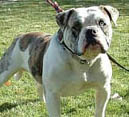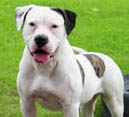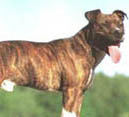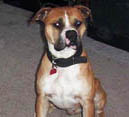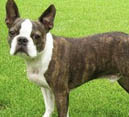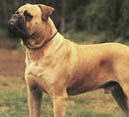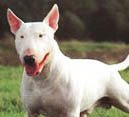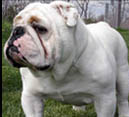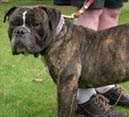Alapaha Blue Blood Bulldog
Breed Description
Alert. Protective. Intelligent. These are the qualities of the Alapaha Blue Blood Bulldog, whose name connotes its regal bearing. Alapahas are said to make wonderful companions. They are also excellent watchdogs and are fiercely protective of whatever they are asked to guard. The Alapaha has a sturdy, muscular frame and is powerfully built, agile, and athletic.
Characteristics
HISTORY/ORIGIN: The origin of the Alapaha Blue Blood dates to the 1800s. Developed in the Alapaha River region of southern Georgia by PaPa Buck Lane, the breed was initially used as a plantation watchdog and cattle dog. Like the American Bulldog, the Alapaha is a descendent of the original Bulldogs that came to the U.S. from England in the 1700s. The breed was established in 1986 by the American Research Foundation, in the working dog category. From 1986 to 2001, ARF has registered or pedigreed just under 700 Alapahas.
HEIGHT: Males: 22 - 25 in.; Females: 20 - 23 in.
WEIGHT: Males: 70 - 100 lbs.; Females: 50 - 70 lbs.
COLORS: Brown, red, blue, white, and black
COAT: Short and stiff
TEMPERAMENT: Protective, intelligent
CARE AND EXERCISE: Minimum grooming of his short coat is necessary. Brush occasionally to remove any dead hairs as they are an average shedder. Bathe only when necessary. Daily walk or an area to play is recommended as they are an athletic, active dog who will enjoy exercise.
HEALTH ISSUES: Entropion (inversion of the eyelids)
CATEGORY: Rare, Working
REGISTRIES: UCA, ABBA (Alapaha Blue-Blood Bulldog Association), ARF
LIVING ENVIRONMENT: Outdoor
American Bulldog
Breed Description
True grit. True devotion. True love. These tributes are used often to describe the American Bulldog -- a hardy, athletic, all-purpose working dog. The American Bulldog is a loving family companion, good with children and other pets, yet at the same time, fearlessly determined. It has been known to display heroic acts of courage in protecting its master. The American Bulldog has also been used to
hunt everything from squirrel to bear, and has been trained to drive cattle and guard stock from predators. The American Bulldog should be evaluated as a working dog, and exaggerations or faults should be penalized in proportion to how much they interfere with the dogs ability to work.
Characteristics
HISTORY/ORIGIN: Bulldogs in England were originally working dogs who drove and caught cattle and guarded their masters' property. At one time, the breed was used in the grueling sport of bull baiting. With the outlawing of the sport in England in 1835, the original type of Bulldog disappeared from Britain and was replaced with the less athletic dog we now know as the English Bulldog. Yet the original Bulldog was preserved by immigrants who brought their working dogs with them to the American South. By the end of World War II, the last remnants of the working English Bulldog were disappearing in the U.S. Thanks to the breeding programs of John D. Johnson and Allen Scott, the breed was brought back from the brink of extinction. The American Bulldog was recognized by the United Kennel Club in 1999 in the rare, working class.
HEIGHT: Males: 22 - 27 inches; Females: 20 - 25 in.
WEIGHT: Male: 75 - 125 lbs.; Female: 60 - 100 lbs.
COLORS: All white, pied, or up to 90% color; brindle or red patches (red is defined as any shade of tan, brown
COAT: The coat is short, close, and stiff to the touch.
TEMPERAMENT: The essential characteristics of the American Bulldog are those which enable it to work as a hog and cattle catching dog, and a protector of personal property. These tasks require a powerful, agile, confident dog with a large head and powerful jaws. The American Bulldog is a gentle, loving family companion who is fearless enough to face an angry bull or a human intruder. Good with children. Good with pets. Puppies should have early socialization.
CARE AND EXERCISE: Brush coat with a firm bristle brush or rubber mitt and bathe only when necessary.
HEALTH ISSUES: A very healthy, hardy dog. Some strains have hip dysplasia. Mast cell tumors are also more common.
CATEGORY: Rare, Working, Guardian
REGISTRIES: UCA, UKC
LIVING ENVIRONMENT: Either Indoor or Outdoor
American Pit Bull Terrier
Breed Description
Known for their intelligence and loyalty American Pit Bull Terriers make excellent, loving and protective companions despite the unfair press they receive. A common question regarding the APBT is, "How is this breed different from the American Staffordshire Terrier?" In the eyes of the United Kennel Club, they are the same breed, but many disagree. Some AKC-registered American Staffordshire
Terriers are dual-registered as American Pit Bull Terriers with the UKC; however, this draws criticism from many who point out that the bloodlines have been separate for too long for these to be considered the same breed. The AKC, on the other hand, does not allow a UKC-registered American Pit Bull Terrier to be registered as an American Staffordshire Terrier. To be dual-registered, the dog must first be an AKC-registered American Staffordshire Terrier and then it can be registered with the UKC as an APBT, but not vice versa. Choose from a responsible breeder and make sure the puppy is properly socialized and handled. Solid training will produce a tranquil, good, obedient, companion dog.
Characteristics
HISTORY/ORIGIN: His ancestors were brought to the United States in the mid - 1800's by Boston-Irish immigrants. Originally bred from a variety of bulldogs and terriers, American breeders increased his weight and gave him a more powerful head. A forbearer to the Staffordshire Bull Terrier, they were originally bred to be a fighting dog. Bull baiting was banned in England in 1835 and these dogs are no longer being bred to fight. There is some complication in registries of this breed. The AKC considers the American Staffordshire Terrier as separate and distinct from the American Pit Bull Terrier, yet the UKC will register both as American Pit Bull Terriers (APBTs).
In America, the Pit Bull flourished. It was one of the most popular breeds, highly prized by a wide variety of people. The Pit Bull was used to represent the US in WW1 artwork; popular companies like RCA and the Buster Brown Shoe Company used the breed as their mascots. A Pit Bull named Petie starred in the popular children's television series, Our Gang; a Pit Bull mix named Stubby became a decorated WWI hero. Pit Bulls accompanied pioneer familes on their explorations. Laura Ingalls Wilder of the popular Little House books owned a working Pit Bulldog named Jack. Famous individuals like Theodore Roosevelt and Helen Keller owned the breed. It was during this time that the Pit Bull truly became America's sweetheart breed, admired, respected and loved.
In 1898 the United Kennel Club was formed with the express intent of providing registration and fighting guidelines for the now officially-named American Pit Bull Terrier. Later, those who wished to distance themselves from the fighting aspect of the breed petitioned the American Kennel Club for recognition of the Pit Bull so that it would be eligible for dog shows and other performance events. The AKC conceded in 1936 but only under the stipulation that the dogs registered with them be called "Staffordshire Terriers", the name of the province in England the breed supposedly originated in. Upon acceptance of the breed, many people dual-registered their dogs with both the AKC and the UKC. Lucenay's Peter (the dog that starred in the Our Gang series) was the first dual-registered Pit Bull/Staffordshire Terrier. The UKC evolved, eventually beginning to register other working-type breeds, and later holding shows similar to those of the AKC. Currently, the UKC is the second largest purebred dog registry in the United States, complete with strict bylaws that ban anyone who is convicted of dog fighting. The American Dog Breeders Association was formed in 1909 because of certain fanciers' opinions that the UKC was not doing it's job protecting and preserving the Pit Bull breed as they felt it should be preserved.
The ADBA's goal is the same now is at was then: to register, promote and preserve the original American Pit Bull Terrier fighting-type dog. The AKC eventually closed it's studbooks to American Pit Bull Terriers. They allowed registration only to those dogs with parents registered as Staffordshire Terriers. For a short period in the 1970's, the AKC reopened its studbooks to American Pit Bull Terriers. In 1973 the AKC added the prefix "American" to the breed's name in an effort to distinguish it from the newly recognized Staffordshire Bull Terrier. Today, only those dogs with AmStaff parents are eligible for registration. Both the UKC and the ADBA allow registration of AmStaffs, but in these organizations the dogs carry the original name, American Pit Bull Terrier.
Today the Pit Bull has evolved into a marvelous working and companion dog, used for purposes as varied as those it originally performed. Pit Bulls are employed as police/armed services dogs, search and rescuers, therapy animals, and livestock workers. They compete in all manner of organized dog sports, from herding to agility to conformation to obedience and the bite sports like Schutzhund and French Ring. They make loving pets for children and seniors, and everyone in between. The are indeed one of the most versatile breeds on the planet. Much of this is owed to the activities it once performed. The harshness and physical demands of the activities molded a strong, healthy, stable animal, one anyone should be proud to own.
HEIGHT: 18 - 22 in.
WEIGHT: 30 - 60 lbs.
COLORS: Any color
COAT: Thick, short, shiny hair
TEMPERAMENT: Courageous, loyal, full of energy; Should be socialized early on with children and other animals.
CARE AND EXERCISE: Regular brushing with a bristle brush or rubbing down his coat with a chamois will keep the coat shiny and clean. Bath only when necessary. Needs a substantial amount of vigorous exercise which needs to be on-leash. Enjoys running along side a bicycle.
HEALTH ISSUES: Mange and heart murmurs. Breeders should be concerned with doing health testing on the sire or dam such as OFA, PENN HIP
CATEGORY: Terrier
REGISTRIES: UCA, UKC, ADBA, CKC, APBR
LIVING ENVIRONMENT: Either Indoor or Outdoor
American Staffordshire Terrier
Breed Description
The American Staffordshire Terrier's muscled build and protective instinct should make strangers beware, yet with their own family they are devoted, gentle and loving. A common question regarding the American Staffordshire Terrier is, "How is this breed different from the American Pit Bull Terrier?" In the eyes of the United Kennel Club, they are the same breed, but many disagree.
Some AKC-registered American Staffordshire Terriers are dual-registered as American Pit Bull Terriers with the UKC; however, this draws criticism from many who point out that the bloodlines have been separate for too long for these to be considered the same breed. The AKC, on the other hand, does not allow a UKC-registered American Pit Bull Terrier to be registered as an American Staffordshire Terrier. To be dual-registered, the dog must first be an AKC-registered American Staffordshire Terrier and then it can be registered with the UKC as an APBT, but not vice versa.They are courageous and a tenacious fighter if provoked. Training can be a challenge because of their pushy yet sensitive character. Their natural temperament towards people is gentle and loving, unfortunately some have been improperly handled giving the American Staffordshire Terrier a bad rap.
Characteristics
HISTORY/ORIGIN: Recently recognized as a distinct breed, he descends from the fighting pits of England and America. A variety of breeds were used to develop the "Amstaff" including the Bull Terrier, the Old English White Terrier, the Black and Tan, the Bulldog, the Mastiff, the Pointer, the Dalmatian and the Staffordshire Bull Terrier. His name was changed from the Staffordshire Terrier to the American Staffordshire Terrier in 1972.
HEIGHT: 17 - 19 in.
WEIGHT: 40 - 50 lbs.
COLORS: Red, fawn, white, black or blue, with white, any shade of brindle
COAT: Smooth, short and dense
TEMPERAMENT: Loyal, intelligent, determined, tough, devoted; does well with children when socialized as a puppy; often does not do well with other pets. Special training because of his nature. Quick to learn but needs an assertive regimen.
CARE AND EXERCISE: Minimal grooming of his coat, dry shampoo or bathe only when necessary. Rubbing his coat will make the coat gleam. Regular daily exercise.
HEALTH ISSUES:Prone to hives caused by stress or insect bites and hip dysplaysia.
CATEGORY: Terrier
REGISTRIES: UCA, AKC, ANKC, CKC, FCI (Group 3), KC (GB), UKC
LIVING ENVIRONMENT: Either Indoor or Outdoor
Banter Bulldogge
Breed Description
The Banter Bulldogge should be a strongly built, athletic, muscular mid-sized Bulldogge/Mastiff. They are a strong working dog, a bully build, with their legs still underneath them. They have a slight under bite and are mostly solid in color with minimal white and will compare to the Old dogs of the area of Brabant, Belgium known as the Brabanter Bullenbeisser.
Most of all they will continue to be a working breed and should be proven at every opportunity. Banter Bulldogge's are athletic and very capable of many of today's canine sports such as weight pull, agility and personal protection. They are also at home doing terrier work or just as a home pet/watchdog.ow much they interfere with the dogs ability to work.
Characteristics
HISTORY/ORIGIN: Created by Todd Tripp of Southeast Ohio in the late 1990's. His vision was to re-create the Brabanter Bullenbeisser of the 1700's in central Belgium province known as Brabant. His foundation consisted of dogs that were Boxer and of a working bull breed, ie. APBT, Staff, AmStaff, American Bulldog. Most of all was the consistency of using a high percentage of Boxer in the foundation brood stock, being very selective in choosing dogs to be in his foundation, and by using selective breeding to reach the final goal. The Brabanter Bullenbeisser was the small Bullenbeisser that was found as a family and working dog in the 1700's and early 1800's. The Brabanter Bullenbeisser was the smaller more bull doggy type of Mastiff used to create the modern day Boxer in conjunction with other Larger Bavarian mastiffs and the obvious infusion of the "Old Time English Bulldogges". It is also widely known that the Brabanter carried very little if any White until the 1830's when the first English type Bulldogge was first imported into Germany. How the name came to be: The word banter means "to address in a witty and teasing manner; good-natured and usually witty and animated joking". This definition matches the temperament of this breed. Also coming from the Old Belgium dogs of the 1700's from the area in and around Brabant know as the Brabanter Bullenbeisser. For these reasons, this breed was named the Banter Bulldogge.
HEIGHT: Males 16-25 in.; Females 14-23 in.
WEIGHT: Males 50 - 85 lbs; Females 50 - 75 lbs Fault: Dogs excessively above or below the standard weight.
COLORS: Fawn, black, red, brindle of all types, with or without black mask. All colors can possess various tints.
COAT: The coat should be short and smooth.
TEMPERAMENT: Easy to train and very obedient. The Banter Bulldogge should be excellent with children and always loyal to its family. It is a good watchdog and will bark to alarm danger or to scare off trespassers. Will be steady to protect if necessary.
CARE AND EXERCISE:They have a lower energy level indoors than out. However, Banter Bulldogges do need to get a good workout or energy can become built up. They are a ruff and tuff dog playing and are fine with other dogs as long as they have been properly socialized. A fun dog with its family always eager for play time and is smart enough to know when play time is over.
HEALTH ISSUES: A very healthy, happy dog. Currently no known health issues.
CATEGORY: Rare, Working
REGISTRIES: IOEBA
LIVING ENVIRONMENT: Outdoor
Boston Terrier
Breed Description
The Boston Terrier is a spritely companion well-known for its intelligence and graceful appearance. It has a compact, well-balanced frame with a smooth coat and short tail. The head is in proportion to the size of the dog and the expression reveals a high degree of intelligence. The body is rather short and well knit, the limbs strong and neatly turned, the tail is short and no feature
is so prominent that the dog appears badly proportioned. The dog conveys an impression of determination, strength and activity, with style of a high order; carriage easy and graceful.
Characteristics
HISTORY/ORIGIN: This breed originated in Boston, Massachusetts, in the late 19th century, by combining the English White Terrier with the English Bulldog, and was originally called the Boston Bull. The English White Terrier as a breed is currently thought to be extinct. Boston Terriers were first acknowledged by the American Kennel Club in 1893.
HEIGHT: 15 - 17 in.
WEIGHT: 10 - 25 lbs.
COLORS: ABrindle, seal, or black with white markings.
COAT: The coat is short, smooth, bright and fine in texture.
TEMPERAMENT: The Boston Terrier is a friendly and lively dog. The breed has an excellent disposition and a high degree of intelligence, which makes the Boston Terrier an incomparable companion.
CARE AND EXERCISE: Brush coat with a firm bristle brush or rubber mitt and bathe only when necessary.
HEALTH ISSUES:Several health issues are of concern in the Boston Terrier: cataracts (both juvenile and adult type), cherry eye, luxating patellas, deafness, heart murmur, and allergies. Curvature of the back, called roaching, might be caused by patella problems with the rear legs, which in turn causes the dog to lean forward onto the forelegs. This might also just be a structural fault with little consequence to the dog. Many Bostons cannot tolerate excessive heat and humidity due to the shortened muzzle, so hot weather brings the danger of heat exhaustion.
CATEGORY: Non-Sporting
REGISTRIES: UCA,CKC, FCI, AKC, UKC, KCGB, CKC, ANKC, NKC, NZKC, APRI
LIVING ENVIRONMENT: Indoor
Bull Mastiff
Breed Description
The Bullmastiff is a dog of incredible strength, keen alertness, and surprising endurance. Although characterized by gentleness, they are a natural guardian of the home and will not back down from a fight. To strangers they are rather standoffish, but they are loving toward their owner. Bullmastiffs are normally very gentle, cheerful and calm. They make a devoted, gentle companion.
They are also known as the "gamekeeper's dog" because they were bred to accompany gamekeepers for the ability to track and overpower a poacher.
Characteristics
HISTORY/ORIGIN: Developed in the late nineteenth century by crossing the Mastiff with the Bulldog. He was breed to combine power, speed and a keen sense of smell with the courage and aggression of a bulldog. In 1924 he was standardized and was officially recognized in England.
HEIGHT: 25 - 27 in.
WEIGHT: 90 - 130 lbs.
COLORS: Shades of brindle, fawn or red. Slight white marking on the chest is permissible, black muzzle.
COAT: Short, smooth, dense.
TEMPERAMENT: Loving, courageous, loyal; Tolerates children; Should be socialized with other animals at an early age.
CARE AND EXERCISE: Minimal brushing of his coat. A good rubdown with a rubber brush or massage glove will remove old dead hairs. Nails should be kept short. Diet and daily exercise need to be balanced to prevent obesity. Daily walks or lost of running space is ideal.
HEALTH ISSUES: Hip dysplasia, gastric torsion and cancer.
CATEGORY: Working
REGISTRIES: UCA, AKC, UKC, ANKC, CKC, FCI (Group 2), KC (GB)
LIVING ENVIRONMENT: Outdoor
Bull Terrier
Breed Description
The Bull Terrier is a loyal, affectionate, loving, and humorous dog. It is strong-willed and, therefore, is not the ideal choice of dog for a first-time dog owner. The ideal owners would be a family that loves horseplay, racing, and games like frisbee. The Bull Terrier has the potential to become a first-class companion dog, but in the wrong hands it can turn out to be a horrid disaster.
Characteristics
HISTORY/ORIGIN: At one time a ferocious fighter, the Bull Terrier was bred aoround 1830 by crossing the English Bulldog with the now extinct White English Terrier. The aim was to get a lighter, more agile fighting dog. They were successful, but by now the breed has become a polite and obedient dog, with an irresistible sense of humor.
HEIGHT: 20 - 22 in.
WEIGHT: WEIGHT: 52 - 62 lbs.
COLORS: Solid white, fawn, brindle, black, red
COAT: Short and dense
TEMPERAMENT: Courageous; good with children when socialized; compatibility with other pets is questionable.
CARE AND EXERCISE: Brush coat with a firm bristle brush and bathe only when necessary. Rubbing of the coat will keep it shiny and clean. Needs plenty of exercise, keep on a leash when in public. Puppies need early socialization to prevent them from becoming dominant.
HEALTH ISSUES: Hereditary zinc deficiency. Some puppies are born deaf.
CATEGORY: Terrier
REGISTRIES: UCA, AKC, ANKC, CKC, FCI (Group 3), KC (GB), UKC
LIVING ENVIRONMENT: Either Indoor or Outdoor
Cane Corso Italiano
Breed Description
The Cane Corso Italiano is a medium-big size dog, strongly built but elegant, with powerful and long muscles, very distinguished, he expresses strength, agility and endurance. The general conformation is that of a mesomorphic animal whose body is longer than the height at the withers, harmonious as regards the form and disharmonious as regards the profile.
The Muzzle is very broad and deep. The width of the muzzle must be almost equal to its length which reaches 3.4/10 of the total length of the head. Its depth is more than 50% the length of the muzzle. Due to the parallels of the muzzle sides and to the fullness and the width of the whole jaw, the anterior face of the muzzle is flat and square. The nasal bridge has a rectilinear profile and it is rather flat. The lower side profile of the muzzle is determined by the upper lips, the suborbital region shows a very slight chisel. The stop is very marked because of the very developed and bulging frontal sinuses and because of the prominent superciliary arches. The neck is slightly arched. The neck shape is of oval section, strong, very muscular. The body is compact, strong and very muscular. The skin is rather thick. The neck is practically without dewlap. The head mustn't have wrinkles. The pigment of the mucous membranes is black. The pigment of the soles and the nails must be dark.
Characteristics
HISTORY/ORIGIN: The Cane Corso Italiano is the original Cane Corso breed. It originated in Italy. Its direct ancestor is the "Canis Pugnax" (the old Roman Molossian) of which he is the light version employed in the hunting of large wild animals and also as an "auxiliary warrior" in battles. For years he has been a precious companion of the Italic populations. Employed as property, cattle and personal guard dog and used for hunting purposes too. In the past this breed was common all over Italy as an ample iconography and historiography testify. In the recent past he has found a excellent preservation area in Southern Italy, especially in Puglia, Lucania and Sannio. His name derives from the Latin "Cohors" which means "Guardian", "Protector". The Cane Corso was accepted into the AKC's miscellaneous class in 2008.
HEIGHT: Males 24-27 in.; Females 23-25 in.
WEIGHT: Males 99-110 lbs.; Females 88-99 lbs.
COLORS: Black, plumb-gray, slate, light gray, blue/gray, light fawn, deer fawn, dark fawn and tubby (very well marked stripes on different shades of fawn and gray). In the fawny and tubby subjects there is a black or gray mask only on the muzzle and shouldn't go beyond the eye line. A small white patch on the chest, on the feet tips and on the nose bridge is accepted.
COAT: The coat is short hair but not smooth, with vitreous texture, shiny, adherent, stiff, very dense, with a light layer that becomes thicker in winter (but never crops up on the covering hair). Its average length is approx. 2/2,5 cm. On the withers, the rump, the back margin of the thighs and on the tail it reaches approx. 3 cm without creating fringes. On the muzzle the hair is very short, smooth, adherent and is not more than 1/1.5 cm.
TEMPERAMENT: Very loyal, willing to please and quiet around the house. The Cane Corso is highly intelligent and very trainable. Active and even-minded, he is an unequalled watch and protection dog. The Cane Corso Italiano is great with children in the family. Docile and affectionate with the owner. They are protective yet gentle. The Cane Corso has a very stable temperament. It makes an excellent guard dog and watchdog. It will not wonder from the home. They stick close to their masters. If necessary he becomes a terrible and brave protector of people, house and property. The Cane Corso is not a fighting dog. They were bred as powerful working dogs for hundreds of years. Therefore they will not go out "looking" for a fight, but on the other hand they will not back down from other dogs who try to dominate them. The Cane Corso requires an experienced owner who knows how to display a natural authority over the dog. It can be aggressive with strangers and other dogs if not socialized or if it sees itself above humans in the pecking order. It should be carefully socialized when it is a pup. It is highly recommended that these dogs become fully obedience trained. If a Cane Corso is fully trained, with an owner who is firm, confident and consistent, setting rules the dog must follow and placing clear limits to what he can and cannot do, along with providing the proper daily mental and physical exercise, the Cane Corso will be an amenable companion. Learn what makes the canine animal tick and treat his breed accordingly. Suspicious of strangers, but wonderful with the family. A well-balanced Corso will put up with strangers if the owners are present. When raised correctly, the dog should be submissive to all members of the family. Corso ears were originally cropped to help them ward off wolves while protecting livestock. Their ears are much more sensitive than the rest of their bodies. Generally, they're practically impervious to pain otherwise, so many Corso owners are often disappointed to find that electrical "invisible fence" containment systems don't deter their dogs.
CARE AND EXERCISE: This very athletic breed needs a lot of regular exercise. They make excellent jogging companions, and if not jogged daily, should be taken on at least one long, brisk daily walks.
HEALTH ISSUES: This is a robust dog, with typical bone and joint problems of the giant breeds. Life expectancy is 10-11 years.
CATEGORY: Mastiff
REGISTRIES: FCI, NKC, APRI, ACR, DRA, AKC
LIVING ENVIRONMENT: Outdoor
English Bulldog
Breed Description
Gentle, friendly, and adoring, with a mischievous dose of stubbornness, the English Bulldog is incessantly loyal to its family. Bulldog resting It usually gets along well with other animals, is particularly fond of children, and does best indoors. Highly spirited as a puppy, the English Bulldog grows up to be a calm adult. The breed prefers not to exercise, can easily overheat, and is prone to drooling and snoring.
Characteristics
HISTORY/ORIGIN: The English Bulldog descended from ancient Mastiffs that originated in Asia and were brought to Europe by nomads. Mastiffs were bred for ferocity in fighting, holding, or bringing down aggressive prey. Crib and Rosa, dated 1817 The Bulldog was bred in the early 13th Century for bull baiting. The short muzzle and wide lower jaw were needed for the dog to clamp itself to the bull's nose like a vise, and the nose had to be upturned so that the dog could still breathe while clinging to the bull. It is mentioned in many historical works, most notably, in Shakespeare's King Henry VI. When animal baiting contests were outlawed in England in 1835, these Bulldogs were increasingly exported to America and also to Germany, where they helped create the Boxer. The last of the working Bulldogs in England were crossed with Pug Dogs to create a stocky, docile, family pet-known today as the English Bulldog. The breed was first registered by the American Kennel Club in 1934 in the non-sporting group and today is a popular show dog throughout the world.
HEIGHT: 12 - 14 in.
WEIGHT:50 - 55 lbs.
COLORS: Uniform color, red brindle, reds; sometimes with a black muzzle.
COAT: Short and smooth.
TEMPERAMENT: Affectionate, but sometimes stubborn; great with kids.
CARE AND EXERCISE: Regular brushing with a rough cloth and minimal exercise. Care should be taken not to over feed as he would prefer not to take any exercise. Special care to powder his fold and wrinkles and under his tail during hot weather. Should not be over exerted in hot weather. He does not make a good dog for the obedience enthusiast.
HEALTH ISSUES: Never leave this dog in a hot car or hot, unventilated area -- they easily overheat. The English Bulldog does drool and snore.
CATEGORY: Non-Sporting
REGISTRIES: UCA, AKC, CKC, FCI (Group 2), KC (GB)
LIVING ENVIRONMENT: Indoor
French Bulldog
Breed Description
Playful, affectionate, and exceptionally good natured, the French Bulldog, or "Frenchie," is bred primarily as a companion pet. But Frenchies also make good watchdogs. Compact and muscular, with a small to medium build, they are a good choice for small living spaces. Frenchies are highly trainable and intelligent, and are happiest when close to their human family.
They are excellent with children and compatible with other pets. They desire alot of attention from their loved ones.
Characteristics
HISTORY/ORIGIN: Speculations abound on the origin of the French Bulldog. The most popular opinion is that the breed originated from the miniature, or toy, Bulldog brought to France by the Nottingham lace workers during the industrial revolution and economic crisis in England. Others believe the French Bulldog descended from the Chincha Bulldog, which lived in ancient Peru. The French Bulldog first appeared in the U.S. in 1896 at the Westminster Kennel Club's show in New York, and was first registered by the American Kennel Club in 1898 in the non-sporting dog group. Britain accepted the breeds club membership in 1912.
HEIGHT: 11 - 13 in.
WEIGHT: 22 - 28 lbs.
COLORS: Brindle, piebald, or fawn
COAT: Short, smooth, close and finely textured.
TEMPERAMENT: Good-natured; excellent with children; compatible with other pets.
CARE AND EXERCISE: Teeth and nails should be tended to regularly. Daily rub down of his coat with a rough cloth. Minimal exercise is needed.
HEALTH ISSUES: Because of his short nose he tends to snore and has some breathing problems. Heat stroke, eye injuries and skin problems.
CATEGORY: Non-Sporting
REGISTRIES: UCA, AKC, ANKC, CKC, FCI (Group 9), KC (GB), UKC
LIVING ENVIRONMENT: Indoor
Olde English Bulldogge
Breed Description
The perfect Olde English Bulldogge should be of medium height to large size with a large head and a very stout, muscular body. The disposition should be outgoing, loyal and courageous. The temperament is to be very stable and trustworthy. Most importantly the Olde English Bulldogge is a healthy dog with out many of the problems affecting the
modern English Bulldogs. Males should be free breeders and females should be free whelpers. The Olde English Bulldogge should be devoid of all breathing problems.
Characteristics
HISTORY/ORIGIN: The exact history of the Olde English Bulldogge is hotly contested, with many breeders claiming that their bloodlines represent the TRUE breed. Instead of taking sides, this site follows the International Olde English Bulldogge Association (IOEBA), which seeks to bring all bloodlines under a single standard. The breed history below is from the IOEBA website:
"The Olde English Bulldogge originated in England between 1600 and 1700. These were the early ancestors to many of the Bull breeds that exist today including the English Bulldog and the American Bulldog. They were bred to participate in blood sports like bull baiting. This so called sport, became quite popular in England through out the middle of the 18th Century. Bull baiting primarily consisted of staking out a bull and allowing several Bulldogges to attack it. A dog of great courage and agility was needed for bull baiting. This dog was of medium size; larger dogs were considered to be the result of mastiff crosses.
Around 1835, laws were passed in England prohibiting bull baiting and the Olde English Bulldogges main purpose of existence vanished. Within a decade the numbers of bulldogs declined drastically almost to extinction. Dog show fanciers eventually decided to reconstruct the breed, but wanted to tone down the aggressive temperament of the original Olde English Bulldogge. They crossed the remnants of the existing stock with the pug and over the years that followed they developed the modern English Bulldog. Unfortunately though, this modern dog is wrought with all kinds of genetic health problems.
The modern Olde English Bulldogge is a reconstruction of the original Olde Bulldogge of the 17th and 18th century. Various genetic crosses have been used in carefully and thoughtfully planned breeding programs to obtain this goal. The foundation of most of today's Olde English Bulldogges can be traced to English Bulldog, American Bulldog, APBT and Mastiff.
These dogs were used very selectively in various combinations to obtain the desired physical and mental traits of the original Olde English Bulldogge. The result has been a good looking Bulldogge of great athletic ability that is much healthier and physically fit without most or all of the problems that plague today's modern English Bulldogs. The goal of all Olde English Bulldogge breeders should be to produce genetically healthier Bulldogges that are free breathers, free breeders, and free whelpers."
HEIGHT: Males: 17 - 23 in. Females: 15 - 21 in.
WEIGHT: 50 - 90 lbs.
COLORS: Any color is acceptable.
COAT: Short
TEMPERAMENT: Stable and trustworthy.
CARE AND EXERCISE: Brush coat with a firm bristle brush or rubber mitt and bathe only when necessary.
HEALTH ISSUES: Very healthy; should not have many of the health problems of the English Bulldog.
CATEGORY: Rare, Working, Guardian
REGISTRIES: IOEBA
LIVING ENVIRONMENT: Indoor
Staffordshire Bull Terrier
Breed Description
The Staffordshire Bull Terriers are known to have great strength for their size. They are stocky and muscular, but should also be active and agile. The breed is the 5th most popular dog in the UK (its place of origin), and it is the only breed to have the words 'totally reliable' in its breed standard. Furthermore, the Staffordshire Bull Terrier is one of only two breeds from over
190 recognized by the UK Kennel Club to have a mention of the breed's suitability with children.
Characteristics
HISTORY/ORIGIN: The Staffordshire Bull Terrier first came into existence in or around the seventeenth century. As bull baiting declined in popularity and dog fighting enjoyed a surge of interest, it became necessary to develop a dog which possessed a longer and more punishing head than the Bulldog and also to combine strength and agility. It is therefore believed that the Staffordshire Bull Terrier was derived from the fighting Bulldog of the day with some terrier blood introduced. This cross produced what was known as the Bull and Terrier or Pit Dog. These dogs were renowned for their courage and tenacity and despite their ferocity in the pit were excellent companions and good with children. In fact it was not unknown for an injured dog to be transported home in a pram with the baby!
Although dog fighting and other barbaric pastimes of the day were patronised by the aristocracy - Lord Camelford reportedly owned a famous dog called 'Belcher'- fighting dogs were also owned by the poorest of families. The pit dog was a favourite with miners and steelworkers and was prevalent amongst the chainmakers of the "Black Country" where the dogs were not only fought for entertainment but provided a working man with valuable extra income when worked against badgers or as ratters.
With the introduction of the Humane Act in 1835, baiting sports and dog fighting became unlawful and a group of men in the Staffordshire area endeavoured to preserve their breed by introducing them to the show world. After much discussion the Standard was written describing the dog's physical attributes and this dog was named the Staffordshire Bull Terrier to differentiate him from the English Bull Terrier.
The Staffordshire Bull Terrier was officially registered by the Kennel Club in 1935 and the first club show for the breed took place in August 1935 at Cradley Heath in the West Midlands where 60 dogs and bitches were entered . The founder club was named The Staffordshire Bull Terrier Club and is affectionately known as 'The Parent Club'. There are now a total of 18 clubs in Great Britain and Northern Ireland ranging from the North of Scotland to the West of England. The breed received championship status in 1938 when CC's were awarded for the first time at the Birmingham National. The first two Champions of the breed were Ch. Gentleman Jim and Ch. Lady Eve.
The popularity of the breed has now spread abroad with well established clubs in many countries including Australia, Eire, France, Germany, Holland, Spain and the USA, to name but a few. Over the years the Staffordshire Bull Terrier has become a successful show dog and a serious contender in the Terrier Group, where they frequently have the highest number of entries of all dogs in the Terrier Group and are occasional winners of Best in Show. More importantly the Stafford has become a popular pet retaining the attributes gained from generations of fighting dogs bred for courage, tenacity and most important: total reliability and affinity with people and in particular children.
HEIGHT: 14 - 16 in.
WEIGHT: 24 - 38 lbs.
COLORS: Brindle, blue, black, red, fawn, white; or any of these with white
COAT: Smooth, short, and dense.
TEMPERAMENT: Reputation for being good with children; often aggressive towards other animals.
CARE AND EXERCISE: Minimal grooming is necessary to keep his coat in top condition. Brush occasionally with a firm bristle brush. Rub down with a towel or chamois to remove loose hairs. Bathe only when necessary. Needs plenty of regular exercise which should consist of play time an daily walks on a leash. He should be kept on a leash in public places.
HEALTH ISSUES: Cataracts, over-heating and breathing problems.
CATEGORY: Terrier
REGISTRIES: UCA, AKC, ANKC, CKC, FCI (Group 3), KC (GB), UKCC
LIVING ENVIRONMENT: Indoor
Valley Bulldog
Breed Description
The Valley Bulldog is derived from the Boxer and the English Bulldog. As a result of this combination, this dog possesses a large head, wide chest, facial wrinkles and loose skin, while keeping a stocky, very muscular, athletic body. The wide upper body displays good muscle tone, narrowing slightly towards the back end, although the buttocks and hips still show strong muscle definition.
The head is blocky with muzzle length ranging from 1 - 2 inches. Lower jaw should be undershot. Facial wrinkles should be obvious from forehead to the nose, and loose skin should be found under the chin; these qualities should remain throughout adulthood. Excess skin wrinkles on the body as puppies normally extend to a tight, healthy body covering. While a proud stance is given with the wide chest, legs should not be bowed, but firm and straight. This is a healthy, athletic, low-maintenance bulldog with the look that few can resist. The breed is rapidly gaining popularity and recognition. Valley Bulldogs adapt well in any environment. They are easily house trained and make excellent house pets. With proper shelter they are fine in hot/humid weather. With adequately-heated shelter they do well in cold climates. These dogs prefer running and playing outside, regardless of temperature.
Characteristics
HISTORY/ORIGIN: The origin of the Valley Bulldog can be traced back as early as the 1950's in the Annapolis Valley of Nova Scotia, Canada. However, it is uncertain whether or not the breed existed in the area even earlier. The Valley Bulldog derives from the English Bulldog and the Boxer.
HEIGHT: Males: 15 - 22 in.; Females: 14 - 20 in.
WEIGHT: Males: 50 - 80 lbs., Females: 40 - 65 lbs.
COLORS: Any color. Common: Fawn, brindle, solid white, white w/fawn or brindle
COAT: Short, smooth
TEMPERAMENT: Very playful, almost clown-like, up to age 1-yr. Adults ? while still very athletic, maintain a calm, laid-back, loving and devoted demeanor. If raised indoors, Valley Bulldogs tend to be more protective. These dogs thrive on human touch. They are happiest when in the presence of their families, and are natural guardians of children. Easily trained, they adapt well to indoor and outdoor environments and are non-aggressive. Love and attention is a must. Depression is possible if neglected of constant human contact.
CARE AND EXERCISE: These dogs are meticulously clean by nature and require very little maintenance. Water preference varies, but they generally love bath time, as this promotes quality time with the owner. The Valley Bulldog requires exercise to maintain muscle tone and all-around good health. If living outdoors with running room, adequate exercise should be no problem. Indoor living would require long walks and frequent periods of play time.
HEALTH ISSUES: As with many breeds, the Valley Bulldog does not escape the possibility of skin allergies, most commonly associated with yeast. Proper diet (discussed with your veterinarian) is a must. Rarely, skin growths/tumors occur.
CATEGORY:
REGISTRIES:
LIVING ENVIRONMENT: Either Indoor or Outdoor
